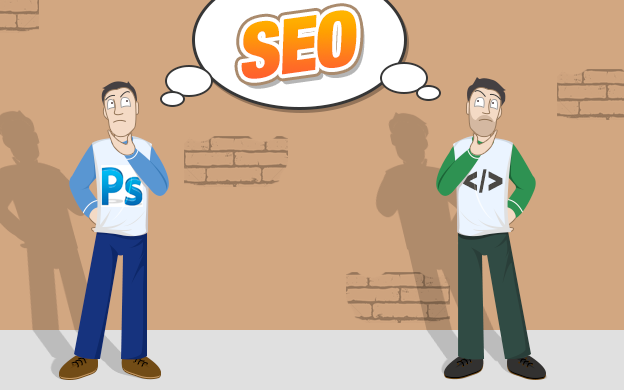SEO Friendly Web Design Services To Make Your Website Look Good & Rank Well
Web designers and search engine optimizers are often at odds with each other. For ace web designers, it’s hard to believe that SEO is such an elementary aspect for a business to triumph in the competitive arena. Rather, they deem that SEO is an evil that curb their creative prowess. From the SEO executives’ point of view, they seldom have the clue about web design trends.
SEO Friendly Web Design Services: Make Your Website Look Good & Rank Well

There are some thousands of SEO firms around the aggressively or non-aggressively tend to follow the right principles. But when the question arises of usability, aesthetics value and the simple functionalities of the website, SEO professionals are left in blank.
However, as a matter of fact, there are many SEO firms with the finest designs with SEO-formatted HTML source code and they get the things working perfectly. These sites create a win-win situation overall – the users’ experience is enriched by the alluring design and the perfect functionalities and Google bots can easily crewel and index the pages. After all, there’s no point in having a beautiful website that does not drive traffic.
Keenness on the Usability
In SEO web designing service, it is the usability that matters. Before going live with your new site, re-assess things whether your site is pleasing, whether the copy is legible, whether the navigation and menus are clearly defined, are there any elements that can distract the users, are there any cloaked texts or links etc. If there are any pop-up ads blocking the view of your site, then get rid of it. Neither a web designer nor a SEO expert can overlook the usability factor.
Google ranks a website that is user-friendly. This was made clear on 9th October 2011, when they had announced the algorithm update called “Above the Fold” update. This algorithm update inspects whether a website has enough content above-the-fold. If a site dedicates majority of screen space to ads above the fold, then it will be penalized. Prior to this, Google had released the Panda update which had tanked hundreds of websites that they believed were distorting the poor user experience.
So, what’s the bottom line? The bottomline is to get the basics right –
#1. Watch Your HTML
A Semantically correct HTML is the dire need of every website. If you are dependent on the blogging platforms (WordPress), make sure you upgrade that to the latest version. HTML5 is ruling the league, but if you are using HTML 4.1, ensure that your doctype is set to the right parameters.
You need not emphasize too much on the correct, non-deprecated tags as these hardly matters from SEO point of view. At one point of time, many webmasters cried that Google favors the primitive “bold” tag over “strong” and hence everyone followed the former, but, it was only after a few days that it was realized that Google had re-adjusted. Make sure that you’re using the updated version of tags and HTML.
#2. Author Bio
Google+ authorship code and rich snippets are ruling the roost. So, if you have a WordPress Blog or some other platform with the similar structure, ensure that your Google authorship is set up properly. Use the same name which you use in your Google+ profile. If you are using a custom platform for your website/blog, make sure the posts have the rightly formatted authorship information so that Google can decode and read easily.
#3. HTML Sitemaps
This goes without saying that Google favors HTML sitemaps to XML. Make sure you have an HTML sitemap and make them easily “navigable. This would prove beneficial as far as the user experience is concerned.
#4. Use Aesthetically Pleasing Images
Do not just put in images in the web pages for the sake of putting it. Dull images don’t serve anything so while using images you need to be very specific about its quality and resolution. From the SEO perspective, you would want your images to be indexed by Google and hence include title as well as ‘alt’ tags in the images. Don’t just stuff in keywords. Just as you have a natural flow in your web copy, insert the explanatory Meta descriptions in the images.
#5. WordPress Plugins
Webmasters using WordPress Plugins have loads of advantage since this WordPress platform comes with a ton of SEO plug-ins which make it easier to run a checklist of the SEO functionalities on your posts. However, while using such plug-ins make sure that they are not ruining your website loading times, usability or performance.
The Final Note –
The aforesaid points just scratch the surface as there is a horde of issues to be taken care of. Exact-match-domains, navigation menus, page loading times, responsive design are to name a few. But, there is this one thing to remember above everything else and that is “Usability”. Usability will reign supreme since, Google’s ever-changing algorithms will continue to prioritize quality and rank a website after evaluating the user-friendliness of the site. SEO and web design should thus go hand-in-hand and no matter how cliché’ it may sound; you need to design a website primarily for the users and not for the search engines.
- The Last Human Job? Reimagining Work in the Age of Automation - January 25, 2025
- Eye-Catching Thumbnails: A Powerful YouTube Channel Growth Tool - November 26, 2023
- Unlocking the Tech Trick: How to Create Gmail and Google Voice Without a Number - October 21, 2023




